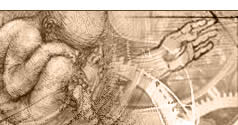 |
 |
 |
 |
 |
 |
 |
 |
|
 |
 |
 |
57 Precision planetary system
|
| Menu | back |
The planetary system surrounding our sun is structured in a very precise manner. However, even minor changes which inevitably occur can lead to situations in which some planets could come into a chaotic orbit after only ten million years. This means that eventually the planets would be lost in the expanse of the universe or would crash into the sun. It is by no means certified that the solar system exists since 4.5 billion years.
|
 |
|
Since Newton discovered the laws of gravity in 1683, we know that the planets orbit around the sun in a very stable manner. They behave as regularly as a clock. Moreover, the distance to the sun follows a mathematical rule (1). It is also remarkable that Venus has a retrograde or opposing self-rotation, contradicting the dust disc theory.
|
| |
|
|
It is proposed that the retrograde self-rotation happened after a collision with an asteroid or meteor, but this is highly unlikely because it would have influenced the path of Venus around the sun. The fact that the path of Venus is very close to a circle (the smallest eccentricity of all planets) argues strongly against.
Long-term stability:
Doubts on the long-term stability of our solar system arose as computer specialist Gerald Jay Sussman and astrophysicist Jack Wisdom proved. They used a special computer built just for such calculations. They found that the planet Pluto had already assumed a chaotic orbit because of interference from other plants in our solar system.
Sussman and Wisdom simulated the motion of all the planets and ascertained that the smaller planets should assume chaotic orbits after approximately fifty million years (2). These calculations were confirmed by the French theoretician Jacques Laskar who obtained nearly the same results in 1990, independent of Sussman and Wisdom (3) (4).
Therefore, the assumption that the planets in our solar system have been orbiting stably for 4.5 billion years, the alleged age of the solar system, has to be considered critically (5).
These 58 | Menu |
back
|
References:
|
| (1) |
Henry M. Morris, Men of Science, Men of God, Creation-Life Publishers, San Diego, California, 1982, pages 4446. |
| (2) |
Gerald Jay Sussman und Jack Wisdom, Chaotic Evolution of the Solar System, Science 257, 3 July, 1992, pages 5662. |
| (3) |
Jacques Laskar, A numerical experiment on the chaotic behaviour of the Solar System, Nature 338, 16 March, 1989, pages 237238. |
| (4) |
Jacques Laskar, The chaotic motion of the Solar System: A numerical estimate of the size of the chaotic zones, Icarus 88, December 1990, pages 266291. |
| (5) |
Hansruedi Stutz, Chaos im Sonnensystem, factum January 1993, page 43. | |
| |
| (Image) http://www.toering42.nl/heelal/?page=3zonnestelsel |
| |
Comment this Site!
|
 |
 |
 |
 |
|

